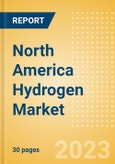Blue hydrogen keeps its high interest in North America more than the rest of the world due to low natural gas prices and potential for storage and utilization of carbon.
Vast renewable power sources are available across the continent, making green hydrogen an equally valuable prospect. In addition, some states and provinces have a large nuclear power fleet, allowing purple hydrogen to be a feasible option.
A long-standing refining and petrochemicals industry means the region has existing knowhow and infrastructure as a point of departure for developing a hydrogen economy.
Key Highlights
The region currently exports a significant amount of LNG, making it possible to repeat this success with hydrogen exports.The region currently holds over 50% of the global upcoming low-carbon production capacity, the interest and engagement level for continuing to develop low carbon hydrogen projects is exponentially increasing.
Transportation and ammonia production are set to become the largest end users of hydrogen in North America. Long-distance and heavy-duty transport are likely applications. Ammonia is used in the production of fertilizers and is an attractive option for transporting hydrogen over long distances.
The region will have some exportation to other markets as well, especially Canada and Mexico.
A large number of innovative demonstration projects are taking place across North America.
Scope
- Hydrogen country market analysis
- Total upcoming capacity and 2030 market size scenarios, highlighting recently announced projects by capacity
- Demand across different application sectors
- National and regional policy support and financial incentives
Reasons to Buy
- Identify the market trends within the country and key players in hydrogen technologies
- Develop market insight of current, in development and announced capacity and latest trends of the sector
- Understand the country's different scenarios for 2030 based on the likeliness of the projects
- Look at the demand in key application areas for the country
- Facilitate the understanding on how and where the market is growing as it is rapidly scaling up to position as one of the main topics of the international and national agenda.








